Natural catastrophes have always been a force to be reckoned with. However, none are quite as destructive as those resulting from severe weather conditions. Over the centuries, humankind has experienced numerous deadly weather events.
In this article, we’ll take a look at the top 10 deadliest weather disasters around the world. In the table below, you’ll find a weather disasters list with basic data, and then we’ll give more details about each of them.
| Est. Deaths | Event | Date |
|---|---|---|
| 4 million | China floods | July 1931 |
| 2 million | Yellow River flood | September 1887 |
| 655,000 | Tangshan earthquake | July 28, 1976 |
| 500,000 | Bhola cyclone | November 13, 1970 |
| 316,000 | Haiti earthquake | January 12, 2010 |
| 300,000 | Coringa cyclone | November 25, 1839 |
| 300,000 | Ganja earthquake | September 30, 1139 |
| 250,000 | Antioch earthquake | May 526 |
| 273,400 | Haiyuan earthquake | December 16, 1920 |
| 230,000 | Aleppo earthquake | October 1, 1138 |
source: Wikipedia
#10. Earthquake in Aleppo, 1138
The quake in Aleppo is one of the most powerful earthquakes (magnitude 7.1) known to humankind. The weather event occurred in several stages, covering the territories of modern northern Syria and southwestern Turkey, later Iran and Azerbaijan. The peak of destruction came on October 11, 1138, when Aleppo suffered. The Damascus chronicler Ibn al-Qalanisi recorded the date of the earthquake - Wednesday, October 11, 1138, and indicated the number of victims - over 230,000.
Aleppo is located along the northern part of a system of large geological faults. This system also includes the Dead Sea depression, which separates the Arabian and African tectonic plates and causes their constant interaction. After the quake, the population of Aleppo recovered only by the beginning of the 19th century.
#9. Earthquake in Haiyuan, 1920
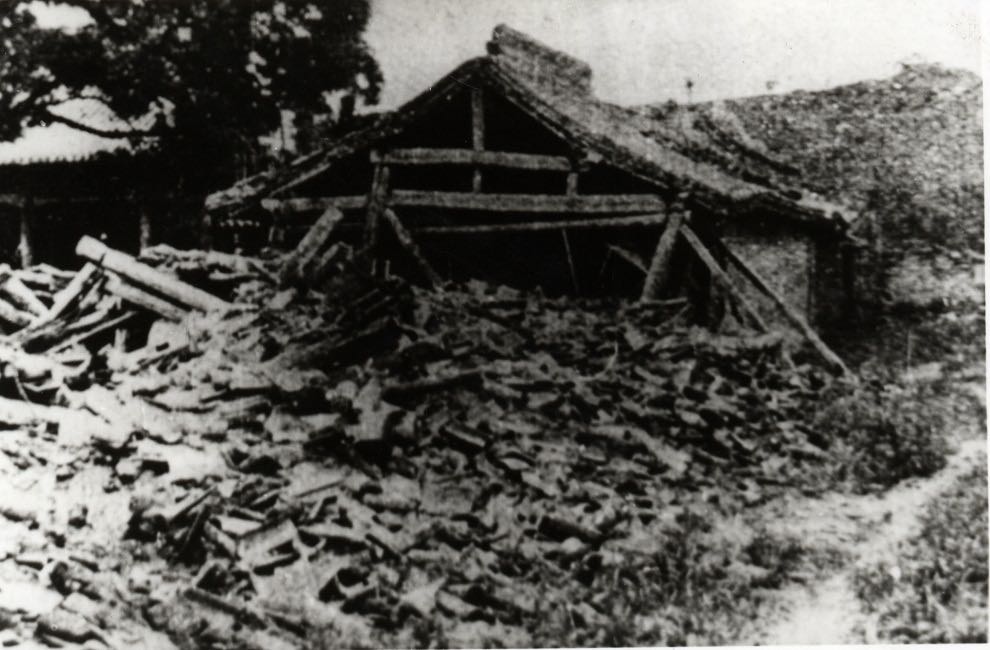 Source: Jingning County Archives
Source: Jingning County Archives
The Haiyuan earthquake struck the Haiyuan County of Ningxia Province in China on December 16, 1920. The catastrophe, with an estimated magnitude of 8.25, killed 235,502 people and left over half a million homeless. The quake was felt as far away as Beijing, Shanghai, and even Japan. The tremors from the disaster were so strong that they caused cracks in the Great Wall of China.
The aftermath of this weather event was devastating, with entire villages and towns completely swept away. It triggered massive landslides and damaged buildings and infrastructure. Many people were trapped under the rubble of collapsed buildings.
#8. Earthquake in Antioch, 526 AD
In 526 AD, a devastating earthquake hit the city of Antioch in the Eastern Roman Empire. This quake is estimated to have had a magnitude of around 7.0 on the Richter scale.
Antioch was one of the largest cities in the Roman Empire at the time, with a population of around 200,000 people. The quake struck during the day, while most inhabitants were going about their daily business. The shaking was intense and lasted for several minutes, causing buildings to collapse and roads to crack open. Many of the city’s important buildings, including the cathedral and the imperial palace, were destroyed.
In the aftermath of the earthquake, Antioch plunged into chaos. The survivors had to live in makeshift shelters, and there was a severe shortage of food and water. The Roman Emperor at the time, Justinian I, had ordered aid to be sent to Antioch, and rebuilding efforts began soon after. It is estimated that over 250,000 people died in the event.
Despite the destruction resulting from the quake, Antioch eventually recovered and remained an important city in the Byzantine Empire for centuries. Today, the city is known as Antakya and is located in modern Turkey. However, recent earthquakes in February 2023 struck it once again, having destroyed about 3,100 buildings and taking away the lives of 50,000 people.
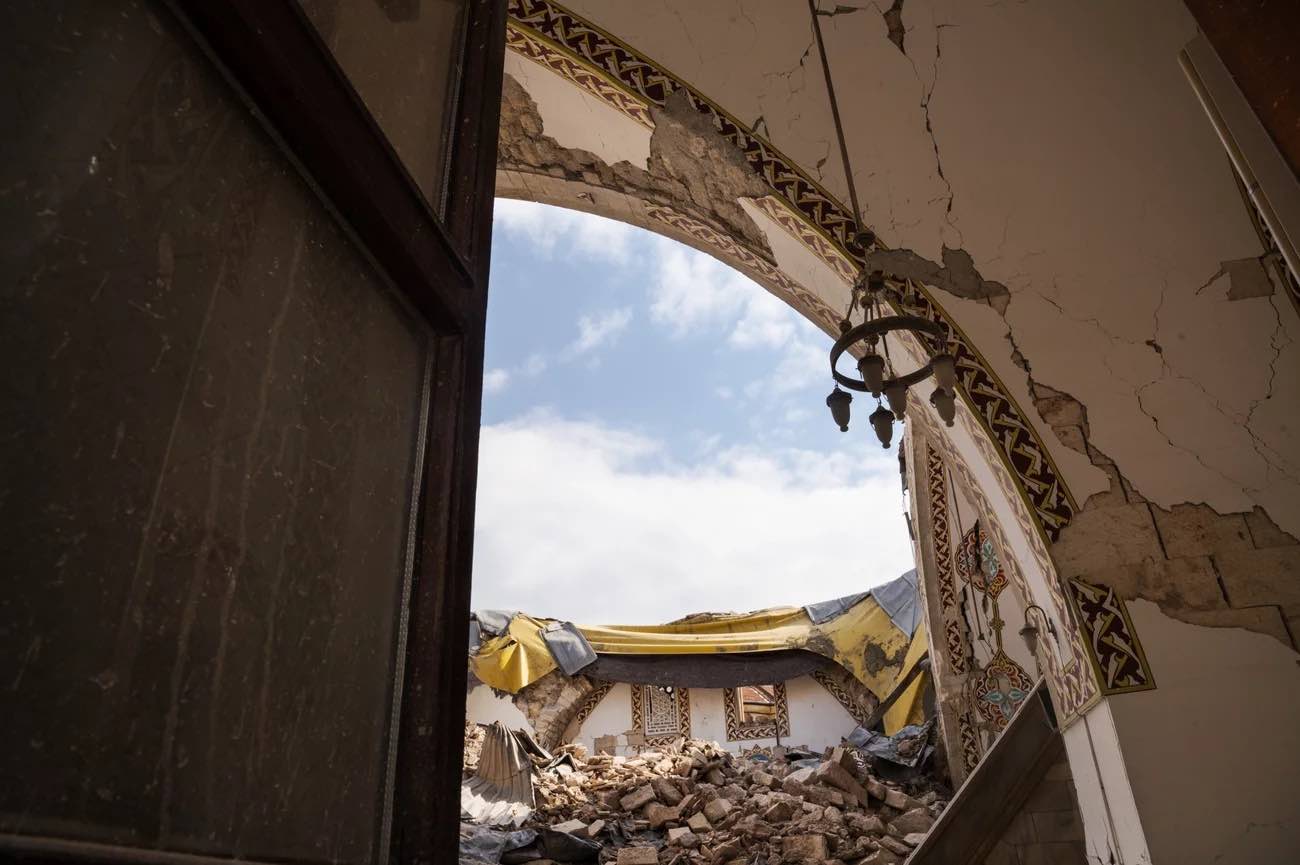 Ruined mosque in Antakya, 2023. Source: NPR.org
Ruined mosque in Antakya, 2023. Source: NPR.org
#7. Earthquake in Ganja, 1139
This earthquake struck the city of Ganja, located in present-day Azerbaijan, in the year 1139. It is considered one of history’s deadliest weather events, with a death toll estimate of about 300,000 and a magnitude of around 7.0 on the Richter scale.
Many buildings, including mosques, palaces, and houses, were destroyed or severely damaged, and the infrastructure was heavily affected. The quake also triggered landslides, caused the nearby river to flood, and formed seven new lakes.
Despite the severity of the earthquake, Ganja was eventually rebuilt and remained an important cultural and economic center in the region.
#6. Cyclone in Coringa, 1839
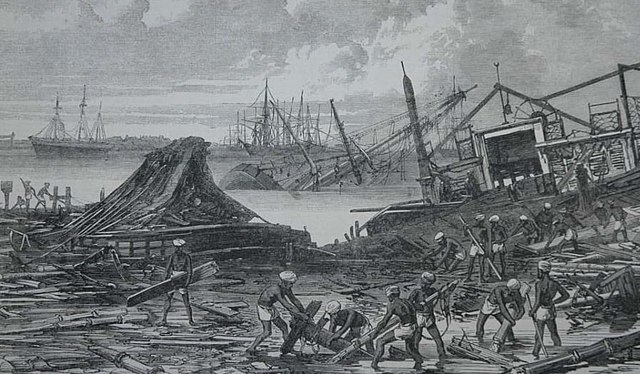 Source: Wikipedia
Source: Wikipedia
The cyclone occurred on November 25, 1839, and was one of the deadliest cyclones on record. It is estimated that the cyclone killed around 300,000 people.
Located in India, Coringa was a bustling port city at the time, and the cyclone destroyed it almost entirely, along with several nearby villages. The city never fully recovered from the disaster.
A combination of factors, including a storm surge, heavy rains, and high winds, caused the cyclone. The storm surge led to massive flooding, which contributed to the high death toll.
The cyclone in Coringa was the first weather event in human history known as a cyclone. The word “cyclone” has the meaning “the coil of a snake”. It was coined by Henry Piddington, an official of the British East India Company.
#5. Haiti Earthquake, 2010
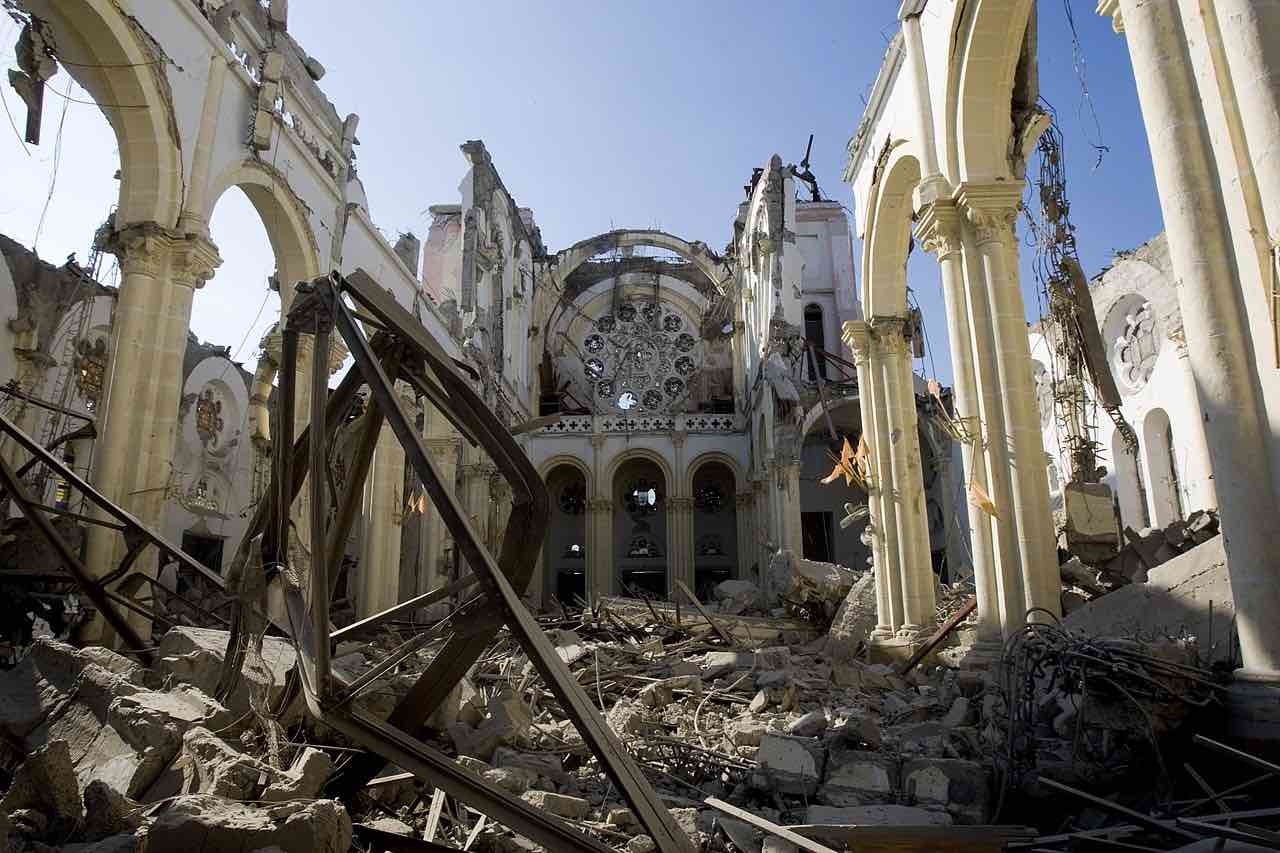 Source: Marco Dormino, CC BY-SA 3.0 IGO, via Wikimedia Commons
Source: Marco Dormino, CC BY-SA 3.0 IGO, via Wikimedia Commons
The 2010 Haiti earthquake struck the Caribbean country of Haiti on January 12, 2010. The 7.0 Richter scale earthquake claimed 200,000 lives and 1.5 million homes.
The quake was centered approximately 16 miles (25 kilometers) west of the capital city of Port-au-Prince, and its effects were felt throughout the country. The weather event caused severe damage to buildings, infrastructure, and other critical facilities, including hospitals and schools. The country’s already weak economy was further strained by the disaster, with many businesses and industries unable to continue operations due to the damage.
#4. Cyclone in Bhola, 1970
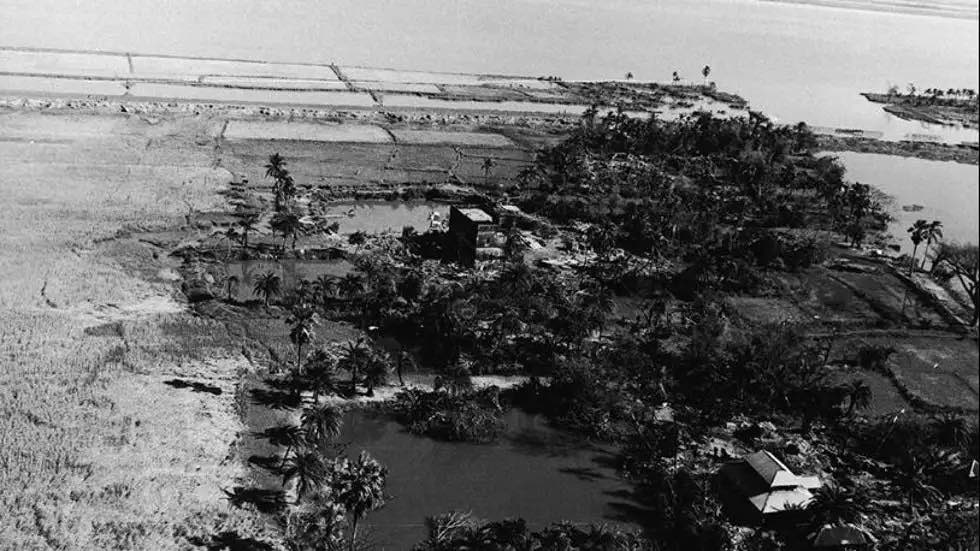 Source: The Weather Channel
Source: The Weather Channel
The 1970 Bhola cyclone is the deadliest tropical cyclone of the 20th century. It made landfall on the coast of what is now Bangladesh on November 12, 1970, and killed around half a million inhabitants. The cyclone was a Category 3 storm, with winds reaching up to 115 mph (185 km/h) and a storm surge of up to 19 feet (6 meters). For comparison, here’s a list of the world’s top 5 deadliest tropical cyclones:
- Bhola 1970, Bangladesh, 300,000 - 500,000
- Bangladesh 1991, Bangladesh, 138,866
- Nargis 2008, Myanmar, 138,373
- Unnamed 1911, Bangladesh, 120,000
- Unnamed 1917, Bangladesh, 70,000
The Bhola cyclone hit at a time when the region was already facing significant political and social upheaval. East Pakistan, as it was known then, was struggling with poverty, corruption, and a growing sense of alienation from the West Pakistan-dominated central government. The cyclone exposed the weakness of the government’s response and deepened the sense of neglect felt by the people of East Pakistan.
The lack of warning and the inadequate infrastructure in the region made the disaster even worse. The government failed to issue a timely warning, and many people were caught off guard when the storm hit. As a result, thousands of people were swept away by the storm surge or drowned in the following flooding.
The Bhola cyclone was a turning point in the history of Bangladesh. It highlighted the need for better disaster preparedness and prompted a reassessment of the country’s political and social priorities.
#3. Earthquake in Tangshan, 1976
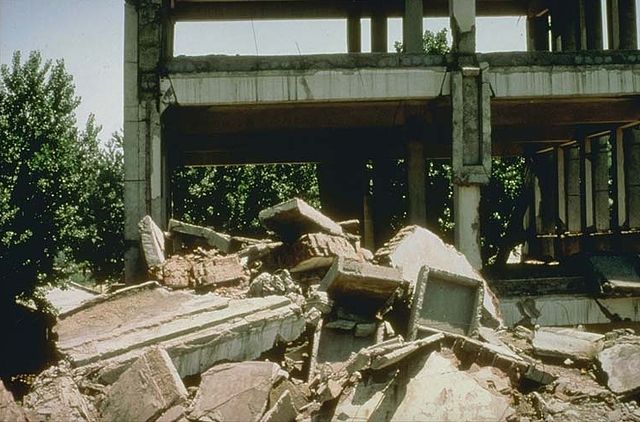 Source: Wikipedia
Source: Wikipedia
This weather event occurred in the city of Tangshan, Hebei province, China, on July 28, 1976. It had a magnitude of 7.6 on the Richter scale, and the estimated death toll was between 240,000 and 655,000.
The earthquake occurred at 3:42 a.m. local time and lasted for about 14 to 16 seconds. It was caused by the movement of the Yanyuan fault, which runs through the Tangshan region. Several neighboring provinces and cities felt the tremors, including Beijing, which is located approximately 87 miles (140 kilometers) northeast of Tangshan.
The earthquake destroyed or severely damaged almost all buildings in Tangshan, including homes, factories, and public buildings. China’s slow disaster response and inadequate building codes got criticism for contributing to the high death toll.
Despite the widespread destruction, Tangshan was eventually rebuilt, and it is now home to over 7 million people. The earthquake remains a significant event in Chinese history, and it has been the subject of numerous documentaries, books, and films.
#2. Yellow River Flood, 1887
The 1887 Yellow River flood was one of the deadliest and most destructive weather disasters in China’s history. The flood resulted from a massive breach in the Yellow River levees near the town of Huayuankou in Henan Province. Heavy rainfall and snowmelt overwhelmed the levees and caused them to collapse. The floodwaters swept through the surrounding countryside, destroying homes, crops, and livestock. About 2 million people were killed, and millions were left homeless.
The Yellow River, known as the “Mother River of China,” is one of the country’s longest and most important rivers. However, its unpredictable nature turned it into a constant source of catastrophic flooding and devastation throughout Chinese history.
The flood had a lasting impact on Chinese politics and culture. It became a symbol of the weakness and incompetence of the Qing dynasty, which could not prevent or effectively respond to the disaster. This, in turn, contributed to the growing discontent and revolution that would eventually lead to the fall of the dynasty in 1911.
#1. Floods in China, 1931
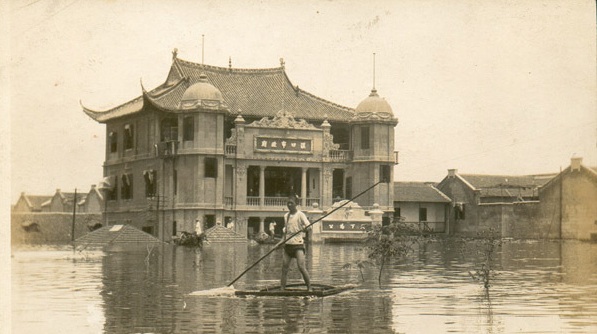 Source: Wikipedia
Source: Wikipedia
In 1931, China faced one of the most devastating weather catastrophes in its history. These floods resulted from heavy rainfall and the overflow of the Yangtze River. They started in the summer of 1931 and lasted for several months. Millions of people were affected, with an estimated death toll of between 1 to 4 million people.
The flooding was so severe that it changed the course of the Yangtze River and created new lakes and islands. The worst affected areas were in central and eastern China, including the provinces of Anhui, Hubei, Hunan, and Jiangxi.
The Chinese government at the time was not equipped to deal with such a large-scale catastrophe, and the resulting relief efforts were slow and inadequate. The government faced criticism for the disaster handling, which led to political unrest and further instability in the country.
Despite China’s significant progress in infrastructure and disaster management, coping with the impacts of climate change, including frequent and severe flooding, remains a challenge for the country.
Conclusion
The deadliest weather disasters highlighted the need for better preparedness for earthquakes, floods, and storms. Since then, earthquake detection, precipitation tracking, storm tracking, and warning systems have advanced a lot. Today, it’s possible to receive severe weather alerts on the smartphone via specialized apps such as RainViewer. But memories of great weather catastrophes remind us of nature’s power and the importance of being ready for a disaster.






